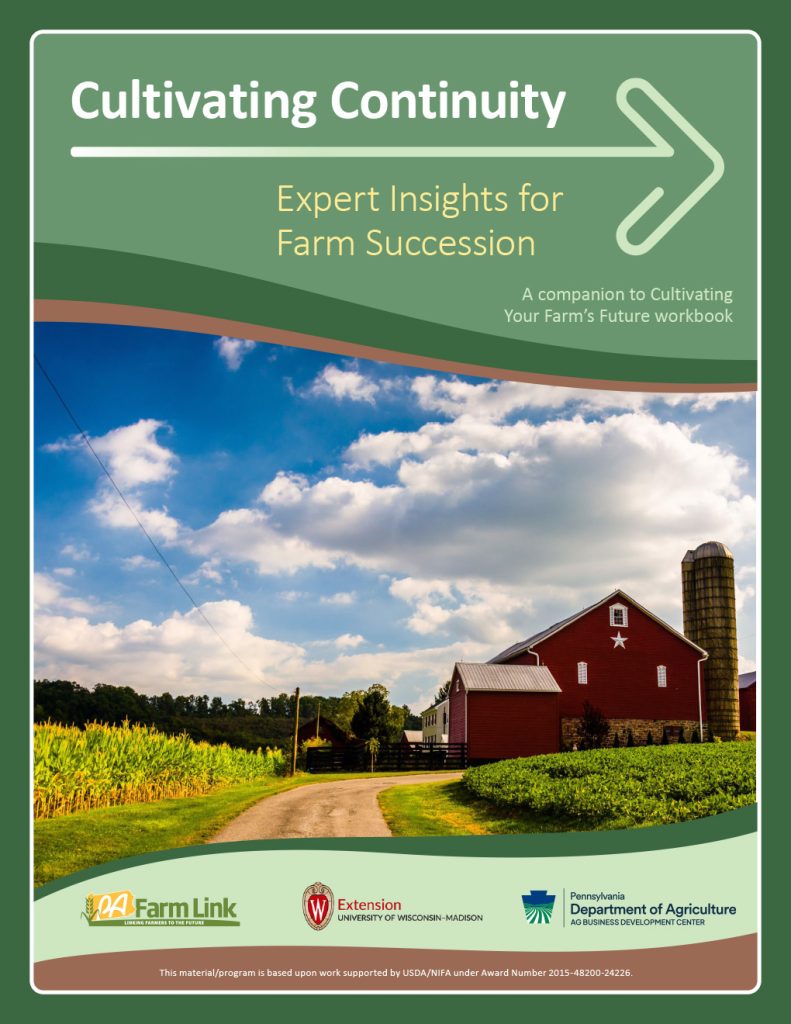
Introduction
Your farm is more than just a business—it’s a legacy. What happens when the unexpected occurs? When life takes an unexpected turn and you’re no longer there to guide the plow, who will inherit your hard-earned acres? Failing to plan can cast a shadow over your farm’s future.
Without a clear plan in place, state laws will determine:
- Who gets what,
- The process for distribution, and
- The financial consequences of those transfers.
Unfortunately, those laws may not align with your vision for your farm.
In this article, we’ll delve into some of the risks of failing to plan—specifically, intestacy, probate, estate tax, and long-term care concerns. Collectively, you may refer to these risks as the legal risks of estate planning, or, rather, failing to develop an estate plan. “Estate planning” means the overall process of making decisions as to how to pass one’s property to others, both during lifetime and at death.[1] This often includes or is related to farm succession planning (the transfer of the business) because of the interrelationships between the business and the individual’s assets. Remember, if you don’t develop an estate plan, state law will provide one for you.
Intestacy
Intestacy occurs when an individual dies without an estate plan, or when their estate plan does not provide for the distribution of all of their assets. Instead, state law provides rules for intestate succession (i.e., who will receive your assets upon your demise). Even though these rules may not achieve individual goals, many people still fail to complete their estate plans. Studies show that, among many reasons, the two main ones for this challenge are (1) the inability to make the hard decisions that an estate plan requires on issues such as the distribution of assets, and (2) struggles with acknowledging your true feelings about possible family beneficiaries.
Despite the challenges, you should craft an estate plan if you don’t want state law to distribute your assets for you.
In short, each state has unique laws that determine who receives your assets upon your death if you haven’t legally executed an estate plan. Let’s see what this might look like in Wisconsin[2] with the Brown farm family.
Robert and Linda Brown
Robert and Linda Brown are a married couple in Wisconsin. They are 78 and 75 years old and have been farming for most of their lives. Neither Robert nor Linda has done any estate planning. They have no wills, trusts, or other transfer mechanisms in place. One day, Robert has a heart attack in the field and passes away. Under Wisconsin law for intestate distribution as of the date of this publication, what happens to Robert’s assets? Let’s look at some examples and discussion questions about how the assets might be distributed in different situations.
Example 1
Say the Browns have two adult children, Christopher and Amanda. In these circumstances, the law provides that the surviving spouse (Linda) receives all of Robert’s assets. Linda also retains her half of the marital property. Christopher and Amanda do not receive anything at this time.
Example 2
In this example, the Brown family’s situation is the same, except Christopher and Amanda are Robert’s children from his first marriage. Linda is Robert’s second wife.
In these circumstances, the law provides that Robert’s assets are split—half to Christopher and half to Amanda. Linda retains her half of the marital property but does not receive any of Robert’s half of the marital property.
Example 3
In this example, Christopher and Amanda are still Robert’s children from his first marriage. Robert is estranged from his first wife, Mary, but Robert and Mary are not legally divorced. Robert lives with Linda, but they have never married.
In these circumstances, the law provides that Mary retains her half of the marital property and receives all of Robert’s half. Linda, Christopher, and Amanda receive nothing.
Example 4
In this example, Christopher and Amanda are still Robert’s children from his first marriage. Robert and his first wife, Mary, are divorced, but Robert never legally married Linda.
In these circumstances, the law provides that Christopher and Amanda each receive half of Robert’s assets. Linda and Mary receive nothing.
Discussion
Amanda plans to continue farming. Christopher works off of the farm. Linda and Mary are both retired.
- How might intestate distribution complicate Amanda’s plans to continue farming?
- As a potential off-farm heir, what might Christopher think of the distribution provided by law?
- What challenges might Linda face?
- What might Mary do in Example 3? Do you think Robert would be happy with Mary receiving all of his assets?
Let’s look at another example—the Miller Brothers Farm.
Matthew and David Miller
Matthew and David Miller are brothers who farm together in a partnership in Wisconsin. Matthew and David are 51 and 53 years old. Matthew is married to Lisa, and they have three children (Andy, Josie, and Joey). Joey is interested in returning to the farm. David never married or had children.
Neither Matthew nor David has done any estate planning. They have no wills, trusts, or other transfer mechanisms in place. Under Wisconsin law for intestate distribution as of the date of this publication, what happens to the assets if one of them passes away? Let’s look at some more examples and discussion questions.
Example 1
Matthew is in a farming accident and passes away. In these circumstances, the law provides that Lisa receives Matthew’s assets, including his portion of the farm assets.
Example 2
Matthew passes away in a farming accident. However, Lisa is his second wife. Joey is their child. Andy and Josie are Matthew’s children with his first wife.
In these circumstances, the law provides that Lisa retains her half of the marital property. Andy and Josie each receive one half of Matthew’s half of the marital property. Joey receives nothing.
Example 3
Instead of Matthew, David is in a farming accident and passes away. Matthew and David’s parents are still alive.
In these circumstances, the law provides that David’s parents receive David’s assets.
Example 4
David is in a farming accident and passes away. Matthew and David’s parents are also deceased.
In these circumstances, the law provides that Matthew receives David’s assets.
Discussion
- What challenges might David have in examples 1 or 2?
- Do you feel that the distribution under example 2 is “fair” or “correct”?
- What issues might occur in examples 3 or 4?
In the examples above, we don’t know who Robert, Matthew, or David hoped their assets would pass to upon their deaths, only what occurred under Wisconsin state law. Remember that intestacy laws vary by state, which means that your state law may cause yet a different outcome. Wherever you are located, distribution of assets under intestate succession may or may not match your individual goals or your goals for the farm. They may cause challenges by (1) distributing property in a way the deceased did not intend, (2) forcing people to work together who might not otherwise choose to, (3) requiring one person to try to buy out another, or any number of other difficulties.
Additionally, the distribution rules created by these laws are outside of your control and may change from time to time if the legislature passes an amendment. It can be risky to rely on state laws for intestate distribution to achieve your estate planning goals.
Instead, executing an estate plan reduces the risks of intestate distribution and increases the chances that your goals for distribution will be accomplished. You still need to make the hard decision of “who gets what,” but you can rest more easily knowing that those wishes will be carried out with a legally binding estate plan.
Probate
Probate is the name of the court process for administering the decedent’s estate. This process occurs after death and includes inventorying assets, paying debts, and distributing the remaining property to heirs or beneficiaries. Probate has several characteristics which may be considered risks, including its public nature, timeline, and related fees.
Because probate is a court process, it is part of public record. Probate filings may be viewed by anyone at the local courthouse, or wherever public access to court documents is available. That record includes an inventory and distribution list (which shares the assets owned upon an individual’s death that are subject to probate), the approximate fair market value of those assets, and who received those assets upon their distribution. Some individuals may not feel comfortable having this information publicly available, whether due to nosy neighbors or disinherited persons, and may therefore wish to avoid probate.
In addition, probate can be a lengthy process, lasting anywhere from 6 months to a few years. During that time, a personal representative (or executor) will be authorized to manage the probate process and administer the decedent’s estate. If no estate planning has occurred, the court or probate registrar will need to authorize a personal representative. During the ongoing process, that personal representative will then be responsible for managing the assets, paying any debts, claims, taxes, or administrative expenses, and distributing the assets to the heirs or named beneficiaries. Managing the assets may look different depending on the personal representative. Some may wish to take an active role in making farm decisions, while others may feel that managing those assets involves limiting their use until the process concludes. The timeline may also impact the farm’s ability to get financing if certain assets are no longer available as collateral due to the ongoing probate process. Because this process can take over a year, it is possible that one or more growing seasons will be impacted.
Finally, some individuals are uncomfortable with the fees related to the probate process. Most states charge an administrative fee equal to a percentage of the assets subject to probate. As an example, in Wisconsin, this fee is 0.2 percent.[3] For an estate of $100,000, this would be a $200 fee. In addition, the personal representative is often entitled to a fee for their services. In Wisconsin, this is equal to 2 percent, plus reimbursement of expenses.[4] For our example estate of $100,000, this would be $2,000. There may be additional filing fees and attorney’s fees if an attorney assists with the process. As these fees add up, some individuals may find probate to be more expensive than they would like. These costs should be weighed against the costs for estate planning to avoid probate.
Alternatively, another attribute of probate is the statute of limitations it imposes on creditors. In Wisconsin, creditors must bring any claims against the estate within 3 to 4 months after the application for probate administration is filed. Failing to bring such a claim within the time limit will bar some claims, meaning that heirs can be assured they receive the assets without any outstanding liens.[5]
Individuals must assess their comfort with the public nature, process length, fees, and limitation on claims of probate to decide whether they wish to use the process or avoid it. While the exact details of fees and time periods vary by state, the general concepts are the same. Failing to plan means that probate will typically be required.
Estate Tax
Like income taxes, estate taxes may be imposed on both the state and federal levels. At the time of this writing, Wisconsin does not impose a state-level estate tax. However, Wisconsin citizens and residents are subject to the federal estate tax, just like everyone else.[6] Much like the graduated income tax brackets, the federal estate tax ranges from 18 to 40 percent on the decedent’s taxable estate.
How do you know if your estate will be subject to the estate tax? Each individual is allowed a “Unified Estate and Gift Tax Credit,” which reduces your total estate subject to tax. Pursuant to the Tax Cuts and Jobs Act of 2017, the Unified Estate and Gift Tax Credit is $13.61 million in 2024. This number is adjusted annually for inflation. However, this provision of the Tax Cuts and Jobs Act of 2017 is set to expire at the end of 2025, at which time the Unified Estate and Gift Tax Credit is expected to return to $5 million adjusted for inflation (estimated to be between $6 and $8 million in 2026).[7]
The Unified Estate and Gift Tax Credit provides an exemption for property to be passed to heirs or beneficiaries without estate or gift tax. Let’s see how it works.
Example 1
Laura Long is an unmarried individual who passes away in 2024 with assets with a net worth of $268,000. Those assets will pass to her heirs or beneficiaries without any estate tax.
Net worth of estate $268,000
Exemption – ($13,610,000)
_______________________
$0 subject to estate tax
Example 2
Thomas Kue is an unmarried individual who passes away in 2024 with assets with a net worth of $14.2 million.
Net worth of estate $14,200,000
Exemption – ($13,610,000)
__________________________
$590,000 potentially subject to estate tax
Example 3
Joshua Walters is an unmarried individual. In 2024, his assets are worth $7.7 million. He passes away in 2027. His assets have appreciated to $8.3 million.
Net worth of estate $8,300,000
Exemption – ($6–8 million)
______________________________
Unknown amount potentially subject to estate tax
When planning for estate tax, it is important to keep in mind that the Unified Estate and Gift Tax Credit is adjusted annually for inflation and may be further changed from time to time by Congress. If Joshua Walters in Example 3 had passed away in 2024, he would have had no estate tax due because the credit was higher than his net worth. However, when the credit value decreased in 2025 and his assets appreciated before his death in 2027, his estate became greater than the Unified Estate and Gift Tax Credit for 2027. Until the credit amount is set for 2027 (the year of his death), it’s unclear exactly how much of his estate will be subject to estate tax. Individuals should continue to evaluate their net worth (including the potential for future income and appreciation) against the potential credit value(s) and plan accordingly.
The Unified Estate and Gift Tax Credit available at death is also impacted by gifts made during life. Each individual has an annual gift exclusion that allows them to give away a specific amount of assets each year tax-free. In 2024, the annual gift tax exclusion is $18,000, meaning that a person can give up to $18,000 to as many people as he or she wants without any tax consequences.[8] However, once that annual gift tax exclusion is exhausted for a given year and recipient, any additional gifts are counted against the Unified Estate and Gift Tax Credit, reducing the credit available at the time of the giver’s death. Let’s see how this might work for Joshua Walters.
Example 4
Joshua Walters is an unmarried individual. In 2024, his assets are worth $7.7 million. He expects his assets to continue to appreciate, and he is worried about his estate exceeding the Unified Estate and Gift Tax Credit.
Joshua begins gifting to his children, nieces, and nephews (10 people in total). Each of the 10 people receive $18,000 from Joshua, reducing his assets from $7.7 million to $7.52 million ($7.7 million – 10 gifts of $18,000 each). Joshua has begun to reduce his estate but has not impacted his Unified Estate and Gift Tax Credit. He may do the same thing next year with the same consequences.
Alternatively, Joshua decides that he would like to gift the same $180,000 in 2024, but he would like to divide it evenly between his three children ($60,000 each). Each of Joshua’s gifts has the same tax consequences—$18,000 passes without consequence—but the $42,000 above the annual gift exclusion reduces his Unified Estate and Gift Tax Credit. Joshua has reduced his assets from $7.7 million to $7.52 million ($7.7 million minus 3 gifts of $60,000 each), but he has also reduced his available Unified Estate and Gift Tax Credit by $126,000 (3 gifts that were each $42,000 in excess of the $18,000 annual gift exclusion).
Joshua must also hope that he outlives his gifts by 3 years. The Internal Revenue Code also includes a 3-year rule[9] that states that a decedent’s estate includes any property transferred within 3 years of death without receiving adequate payment in return.
Up to this point, our examples have only addressed unmarried individuals. We will now advance our understanding of the estate tax to include married individuals. First, transfers to spouses (whether by gift or through the estate) are excluded from estate and gift tax.[10] They do not reduce the Unified Estate and Gift Tax Credit.
In addition, the surviving spouse of a decedent may elect ‘portability’ and claim the unused Unified Estate and Gift Tax Credit of their deceased spouse for future use.[11] Here’s an example.
Example 5
Emily and Joseph Rodriguez are a married couple in Wisconsin. Together, they have a net worth of $2 million. Emily passes away in 2024. We will assume that all of their property is marital property, meaning that her half of the property (and her estate) is valued at $1 million. She leaves all of her property to Joseph.
At the time of her death in 2024, the Unified Estate and Gift Tax Credit is $13.61 million. Because her $1 million estate is transferred to her spouse, Joseph, it does not reduce her Unified Estate and Gift Tax Credit. Joseph elects portability, which allows him to add Emily’s unused Unified Estate and Gift Tax Credit of $13.61 million to his future Unified Estate and Gift Tax Credit.
When Joseph wins $10 million in the lottery in 2026 before passing away in 2027, he will have a net estate of $12 million (plus appreciation). Although he is subject to the reduced Unified Estate and Gift Tax Credit of 2027 (let’s say $8 million), he won’t owe any estate tax because he can use both his and Emily’s unused Unified Estate and Gift Tax Credit.
Net worth of estate $12,000,000
Joseph’s Exemption – ($8,000,000)
Emily’s Ported Exemption – ($13,610,000)
_______________________
$0 subject to estate tax
Another consideration of managing the Unified Estate and Gift Tax Credit is the impact on tax basis in an asset. When an individual purchases an asset, such as a piece of farmland, the individual receives a tax basis in the asset at that price. If that farmland appreciates in value and the individual later sells that farmland, the individual will owe tax on that sale for any gain. You may think of it generally as:
Tax = Tax Rate * [New Sale Price – Tax Basis]
OR
Tax = Tax Rate * Gain
The purchaser then has a new tax basis at the price that they paid.
Conversely, an asset that is gifted does not have any change in basis. The recipient takes the giver’s tax basis as their own.[12] However, a transfer on death may allow for a step-up in basis to fair market value.[13] Let’s see how it works.
Example 6
Michael Williams purchased 100 acres of farmland in 2012 for $4,000 per acre. Today, farmland in the area is selling at $9,000 per acre. Michael’s health is declining, and he is ready to transition the land to his child, Rory. He is debating between selling the land to Rory at the fair market value of $9,000 per acre, gifting the land to Rory, or leaving the land to Rory through his will. Let’s compare.
| Sale at $9,000 per acre | Gift | Will | |
| Michael’s Basis | $400,000 | $400,000 | $400,000 |
| Rory’s Cost | $900,000 | $0 | $0 |
| Michael’s Taxes | Tax Rate * $500,000 | $0 | $0 |
| Rory’s New Basis | $900,000 | $400,000 | Value at Michael’s death ($900,000 ± appreciation/depreciation before Michael’s death) |
If Michael sells or gifts the property, it will not be part of his estate (assuming he lives at least 3 more years). However, if he leaves it to Rory in his will, it will be part of the estate. Whether there will be an impact to estate tax depends on Michael’s overall estate and his Unified Estate and Gift Tax Credit.
Estate tax is a complex topic with further rules to consider. Remember that this publication is provided for educational purposes only. Consider consulting a qualified accountant and attorney for tax and legal advice on your specific situation.
Long-Term Care and Retirement Expenses
As individuals plan for farm succession, it may be tempting to focus on trying to avoid intestacy, probate, and estate tax. However, it’s important to also consider the long-term needs of the older generation. Are there sufficient funds to provide for lifestyle and care needs once the farm transitions?
Creating an estimated monthly budget of expected income and expenses (without the farm) can be a good place to start. Is there enough income or savings to support your needs? Will sale proceeds or rental income be important to sustain your future budget?
After planning for the “regular” days, ask yourself: Are there funds or assets available to pay for in-home or nursing home care if needed? Alternatively, is your plan to qualify for Medicaid? Medicaid is a joint state and federal health insurance program with financial eligibility requirements that may assist individuals in paying for long-term care. Medicaid is different than Medicare, which is a federal health insurance program for people 65 or older and some people under 65 with certain disabilities or conditions. Medicaid offers benefits that Medicare doesn’t normally cover, like nursing home care and personal care services.[14]
The financial requirements to qualify for Medicaid are stringent and include a 5-year lookback period (in all states except California) to ensure that the individual applying has not transferred assets for less than fair market value during that time. In addition, state Medicaid programs must attempt to recover the cost of certain benefits from the Medicaid enrollee’s estate. That means that while some assets may be exempt during lifetime, they may still be subject to recovery by the state upon the individual’s death.
Individuals considering the use of Medicaid should consult with an attorney or other qualified advisor to learn more. Another chapter in this publication, Long-Term Care Planning for Farm Operations, explores this topic further.
Conclusion
In short, failing to plan is still a plan—a plan determined by law instead of by individual choice. Individuals should carefully consider the potential implications of intestacy, probate, estate tax, and long-term care needs in their estate and succession plans and decide how they wish to handle each concern.
[1] McEowen, Roger A. 2024. Principles of Agricultural Law. Ankeny, IA: McEowen P.L.C.
[2] Wisconsin is a community property state. For purposes of the examples contained in this section on intestacy, we will assume that all property owned by a spouse is marital property. Existence of individual property will change the distribution beyond the examples shown here.
[3] Wis. Stat. §814.66 (2021–2022).
[4] Wis. Stat. §857.05 (2021–2022).
[5] Wis. Stat. § 859.02 (2021–2022).
[6] 26 U.S. Code § 2001
[7] 26 U.S. Code § 2010(c)(3)(C)
[8] 26 U.S. Code § 2503
[9] 26 U.S.C. § 2035
[10] 26 U.S.C. § 2056
[11] 26 U.S.C. § 2010
[12] 26 U.S.C. § 1015
[13] 26 U.S.C. § 1014
[14] U.S. Department of Health and Human Services. 2022. What’s the difference between Medicare and Medicaid? December 8. Accessed June 14, 2024. https://www.hhs.gov/answers/medicare-and-medicaid/what-is-the-difference-between-medicare-medicaid/index.html.
Reflection Question
- How do you feel about state law determining the distribution of your assets through intestacy laws if you pass away without an estate plan?
- What challenges do you think your family may face during the probate process?
- How might estate taxes impact the financial stability of your farm?
The worksheet titled Evaluating the “D” Risks (pp. 38-41) from Cultivating Your Farm’s Future: A workbook for farm succession planning may help you start a conversation around the topic from this chapter.

This article is a sample from a larger publication about farm succession, titled “Cultivating Continuity: Expert Insights for Farm Succession“
About the Author

Kelly T. Wilfert
Farm Law Outreach Specialist
Kelly T. Wilfert is a Farm Management Outreach Specialist with a focus on legal issues impacting farms, agribusinesses, and rural communities. While Kelly does not provide legal advice, her programming aims to improve farm access to legal services by helping interpret legal concepts, regulations, and case law. She identifies strategies for managing legal risk and maintaining or improving the success of implemented legal tools.

 Inherit It or Marry It… or Co-own a Farm?
Inherit It or Marry It… or Co-own a Farm? Values, Vision, and Intentions for Farm Succession
Values, Vision, and Intentions for Farm Succession Building the Bridge of Trust in Farm Succession
Building the Bridge of Trust in Farm Succession Tensions of Farm Succession
Tensions of Farm Succession


